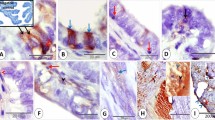Summary
Formalin-fixed, paraffin-embedded samples from 25 ovarian granulosa cell tumours and six poorly differentiated ovarian carcinomas examined immunohistochemically for the presence of estradiol, testosterone and progesterone. Twenty-four of the 25 granulosa cell tumours stained for estradiol predominantly in granulosa cells and also in the theca cells, but none of the carcinomas were positive. All the granulosa cell tumours and five out of six carcinomas were positive for progesterone, while 13 granulosa cell tumours and three carcinomas stained moderately positive for testosterone.
No clear-cut relationship was observed between positivity for estradiol in granulosa cell tumours and occurrence of endometrial hyperplasia. In two cases of granulosa cell tumours, 1–15% cells showed ultrastructural features of steroid synthesis: i.e. moderate to abundant smooth endoplasmic reticulum and mitochondria with tubular cristae. This is in contrast with the diffuse immunohistochemical staining reaction of granulosa cell tumours with antisteroid antibodies.
To evalutate the significance of immunohistochemical for estradiol, four estradiol-containing tumours were tested by radioimmunoassay for the presence of estradiol before and after dehydration. As expected, treatment with organic solvent leads to a drastic reduction in estradiol content below the detection level of the assay. The result indicate that immunohistochemical staining for steroids of paraffin-embedded granulosa cell tumours if of limited value.
Similar content being viewed by others
References
De Jong, F. H., Hey, A. H. &Van der Molen, H. J. (1974) Oestradiol-17β and testosterone and productionin vitro.J. Endocrinol 20, 409–19.
Fox, H., Agrawal, K. &Langley, F. A. (1975) A clinicopathological study of 92 cases of granulosa cell tumour of the ovary with special reference to the factors influencing progrnosis.Cancer,35, 231–41.
Fox, H. (1985) Sexcord-stromal tumours of the ovary.J. Pathol. 145, 127–48.
Gaffney, E. F., Majumdar, B., Hertzler, G. L., Zane, R., Furlong, B. &Breding, E. (1983) Ovarian granulosa cell tumors: immunohistochemical localization of estradiol and ultrastructure, with functional correlations.Obstet. Gynecol. 61, 311–19.
Giuntoli, R. L., Celebre, J. A., Wu, C. H., Wheeler, H. &Mikuta, J. J. (1976) Androgenic function of a granulosa cell tumor.Obstet. Gynecol. 47, 77–9.
Gondos, B. (1969) Ultrastructure of a metastatic granulosa-theca cell tumor.Cancer 24, 954–9.
Jarabak, J. &Talerman, A. (1983) Virilization due to metastazing granulosa cell tumor.Int. J. Gynecol. Pathol. 2, 316–24.
Klemi, P. J. &Gronroos, M. (1979) An ultrastructural and clinical study of theca and granulosa cell tumors.Int. J. Gynecol. Obstet. 17, 219–25.
Kurman, R. J., Andrade, D., Goebelsmann, U. &Taylor, C. R. (1978) An immunohistological study of steroid localization in Serotli-Leydig tumors of the ovary and testis.Cancer 42, 1772–83.
Kurman, R. J., Goebelsmann, U. &Taylor, C. R. (1979) Steroid localisation in granulosa theca tumor of the ovary.Cancer 43, 2377–84.
Kurman, R. J., Goebelsmann, U. &Taylor, C. R. (1981) Localisation of steroid hormones in functional ovarian tumors. InDiagnostic Immunohistochemistry. Masson Monographs in Diagnostic Pathology pp. 137–48. New York: Masson Publishing.
Kurman, R. J., Ganjei, P. &Nadji, M. (1984) Contributions of immunohistochemistry to the diagnosis and study of ovarian neoplasms.Int. J. Gynecol. Pathol. 3, 3–26.
Maccaulay, M. A., Weliky, I. &Schulz, R. A. (1976) Ultrastructure of a biosynthetically active granulosa cell tumor.Lab. Invest. 17, 562–70.
Nishi, K. Tokunaga, A., Shimizu, Y., Yoshiyuki, T., Wada, M., Matsukura, N., Tanaka, N., Onda, M. &Asano, G. (1987) Immunohistochemical study of intracellular estradiol in human gastric cancer.Cancer 59, 1328–32.
Norris, H. J. &Taylor, H. B. (1969) Virilisation associated with cystic granulosa cell tumors.Obstet. Gynecol. 34, 629–35.
Pederson, P. H. &Larson, J. F. (1970) Ultrastructure of a granulosa cell tumor.Acta. Obstet. Gynecol. Scand. 49, 105–10.
Salazar, H. &Gonzalez-Angulo, A. (1984) Ultrastructural diagnosis in gynecological pathology.Clin. Obstet. Gynecol. 11, 25–77.
Scully, R. E. (1977) Estrogen and endometrial carcinoma.Hum. Path. 8, 481–83.
Scully, R. E. (1979) Tumors of the ovary and the maldeveloped gonads. InAtlas of tumor pathology. 2nd series, fascile no. 16 Washington DC: Armed Forces Institutes of Pathology.
Toker, C. (1968) Ultrastructure of a granulosa cell tumor.Am. J. Obstet. Gynecol. 100, 779–84.
Wilansky, D. L., Scott, B. H. &Lachange, R. C. (1976) Masculinizing granulosa cell tumor.Can. Med. Assoc. J. 115, 545–6.
Young, R. H. &Scully, R. E. Ovarian sexcord-stromal tumors: recent advances and current status.Clin. Obstet. Gynecol. 11, 93–134.
Author information
Authors and Affiliations
Rights and permissions
About this article
Cite this article
Chadha, S., de Jong, F., van Vroonhoven, C.C.J. et al. Feasibility of the immunohistochemical detection of endogenous steroids in paraffin-embedded ovarian tumours. Histochem J 22, 269–275 (1990). https://doi.org/10.1007/BF01387182
Received:
Revised:
Issue Date:
DOI: https://doi.org/10.1007/BF01387182




